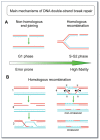The two faces of DNA repair: disease and therapy
- PMID: 24003649
- PMCID: PMC3965295
The two faces of DNA repair: disease and therapy
Abstract
Our genome is the blueprint for our bodies. A number of sophisticated mechanisms help protect our genome from life-threatening cellular mistakes and environmental insults. Much current research focuses on understanding these mechanisms, how they prevent disease, and whether they can be targeted for therapeutic purposes. Here, we review the main mechanisms maintaining genome integrity, how their malfunctioning results in disease, and the exciting progress toward targeting these mechanisms for cancer treatments.
Figures





References
-
- Lindahl T. Instability and decay of the primary structure of DNA. Nature. 1993;362:709–15. - PubMed
-
- Hoeijmakers JH. Genome maintenance mechanisms for preventing cancer. Nature. 2001;411:366–74. - PubMed
-
- Wyman C, Kanaar R. DNA double-strand break repair: all’s well that ends well. Annu Rev Genet. 2006;40:363–83. - PubMed
-
- Khanna KK, Jackson SP. DNA double-strand breaks: signaling, repair and the cancer connection. Nat Genet. 2001;27:247–54. - PubMed
MeSH terms
Substances
Grants and funding
LinkOut - more resources
Full Text Sources
